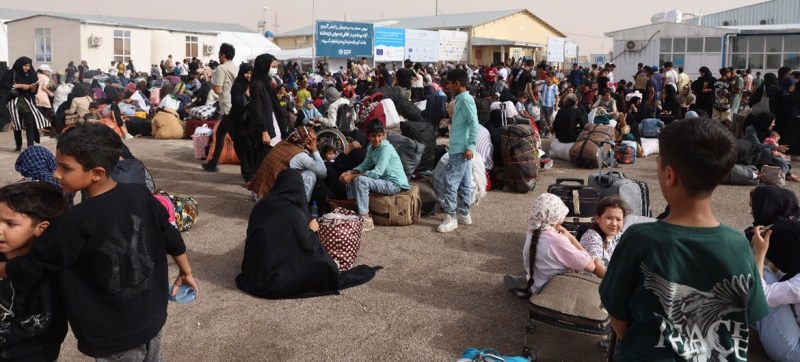- Observe July Uprising Annually to Guard Against Autocracy |
- Human Rights a Key Driver of Climate Change Progress |
- Security measures at Shahjalal Airport enhanced |
- Polls in early next year: Prof Yunus tells Marco Rubio |
- Bangladesh’s Apparel Exports to US Hit $7.34bn in Decade |
Afghan Returns From Iran Strain Fragile Support Systems

Afghans who have been deported from Iran gather at the Islam Qala border crossing in western Afghanistan.
More than 700,000 Afghan migrants have returned from Iran so far this year, including 256,000 in June alone, the UN International Organization for Migration (IOM) reported on Monday, warning of immense pressures on Afghanistan’s overstretched support systems.
Ninety-nine per cent of the returnees were undocumented, and 70 per cent were forcibly returned, with a steep rise in families being deported – a shift from earlier months, when most returnees were single young men, according to the UN agency.
The rise follows a March decision by the Iranian Government requiring all undocumented Afghans to leave the country.
Conditions deteriorated further after the recent 12-day conflict between Iran and Israel, which caused the daily refugee crossings to skyrocket from about 5,000 to nearly 30,000, according to Arafat Jamal, the UN Refugee Agency (UNHCR) representative in Afghanistan.
“They are coming in buses, and sometimes five buses arrive at one time with families and others, and the people are let out of the bus and they are simply bewildered, disoriented, tired, and hungry as well,” he told UN News, describing the scene at a border crossing.
“This has been exacerbated by the war, but I must say it has been part of an underlying trend that we have seen of returns from Iran, some of which are voluntary, but a large portion were also deportations.”
Afghanistan, already grappling with economic collapse and a chronic humanitarian crisis, is unprepared to absorb such large-scale returns.
The 2025 Humanitarian Needs and Response Plan calls for $2.42 billion in funding, but only 22.2 per cent has been secured to date.
“The scale of returns is deeply alarming and demands a stronger and more immediate international response,” said IOM Director General Amy Pope. “Afghanistan cannot manage this alone.”
Meanwhile, UNHCR, alongside partners, is working to address the urgent needs of those arriving – food, water, shelter, protection. However, its programmes are also under severe strain due to limited funding.
The agency had to drastically reduce its cash assistance to returnee families at the border from $2,000 per family to just $156.
“We are not able to help enough women, and we are also hurting local communities,” added Mr Jamal.
In response to the growing crisis, the UN Central Emergency Response Fund (CERF) has allocated $1.7 million to the World Food Programme (WFP) to support drought-affected families in Faryab Province.
The funds will provide cash assistance to some 8,000 families in the region, where over a third of the rural population is already facing crisis or emergency levels of acute food insecurity.
“Acting ahead of predicted hazards to prevent or reduce humanitarian impacts on communities is more important than ever,” said Isabelle Moussard Carlsen, Head of OCHA Afghanistan, adding, “When humanitarian action globally and in Afghanistan is underfunded... we must make the most of every dollar.”

